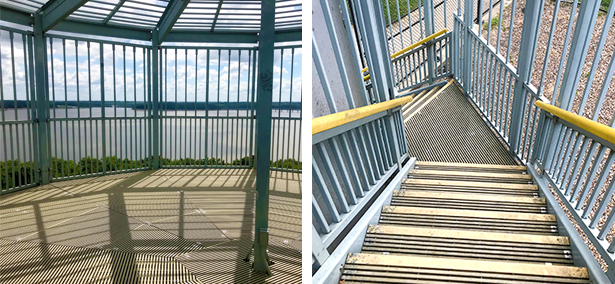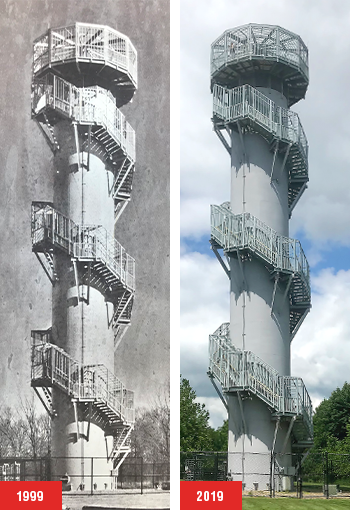Durability Study: Cordova Park Observation Tower is Still a Winner After 20 Years


Rated as the #1 thing to do in Otley, IA, by a major travel website, the 123-foot Cordova Park Observation Tower is a balanced representation of how steel and FRP can come together to form a complex structure which shares similar design characteristics with lighthouses.
Prior to being a tourist attraction, the pipe tower was used for water storage and then decommissioned. Upon the completion of a feasibility study, it was concluded that structural work would be needed to strengthen the tower shell if the spiral walkways were constructed with aluminum or steel. The additional reinforcement costs and conductivity concerns turned engineers to a lightweight and nonconductive design using pultruded fiberglass.
Over a period of eight months, Strongwell’s engineering staff and Calhoun-Burns and Associates worked together to design and attach 170 composite stair treads, landing structures, stringers, handrail, and a cage system to the steel structure. This transformation turned the once abandoned structure into the tallest public observation tower in the Midwest in a public park.
The amended refurbishment scope with composite materials was also how this structure was chosen by the Consulting Engineering Council of Iowa as the Grand Conceptor Awardee in the Engineering Excellence Awards category in 1999.
| TECHNICAL DATA |
|---|
| Product: Observation Tower Stairs |
| Process: Pultrusion |
| Materials & Sizes:
|
| For: Cordova Park, Otley, IA |
| User: Public |
Since a short time after its opening, the tower has charged a modest entry fee of 50 cents per patron to fund potential refurbishment projects. Over 20 years and more than 325,000 visitors later, the owner of the structure, Marion County Conservation Department, reported that they have performed virtually no maintenance on the fiberglass portions of the structures since its public opening in 1999.